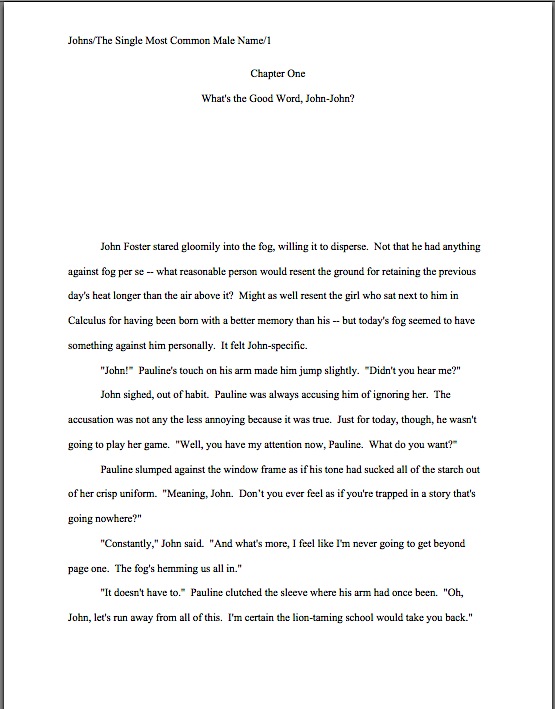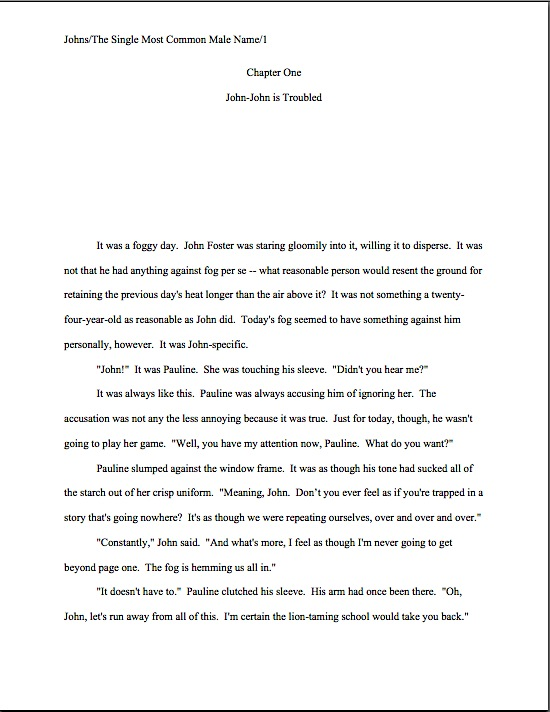An old friend presented me with a stumper yesterday, campers: although neither a teacher nor a writer himself, Nate had just been asked to teach a writing class at work. Specifically, he had been allotted six hours in which to transform the prose stylings of the fine folks in another department from argumentatively sound but hard to follow into…well, the company’s owner had not been all that clear about what better writing would mean in that context, but he certainly was adamant that he wanted it.
Oh, and would the day after tomorrow be too soon to offer the class? Under the circumstances, I would have called me in a panic, too.
Already, I see the logical conclusion-huggers out there scratching their heads. “But Anne,” the rational point out, as they are wont to do, “if this storyline popped up in a novel, readers would find it implausible. In the first place, if the owner doesn’t know what good writing is, how can he set writing standards for the department? If he does not know how his staff is falling short of those standards, how is the class — which, if my calculations are correct, should convene sometime tomorrow morning — to address the problems? And if the boss is so darned worried about his employees’ writing, wouldn’t it make more sense to bring in someone with experience diagnosing writing problems and helping writers iron them out?”
There you go, expecting the real world to be as plausible as fiction. I’ve said it before, and I shall no doubt say it again: reality is a lousy writer.
Case in point: Nate’s predicament is exceptional not in that he’s fallen victim to the astonishingly pervasive notion that anyone who can express himself well on paper must perforce be capable of teaching others how to do it — which, as anyone who has attended an authors’ panel on craft issues at a writers’ conference could tell you, does not always bear out in practice — but insofar as he happened to have gone to elementary school with an editor willing to help him come up with a last-minute lesson plan. Makeshift workplace writing seminars seem to have been on the rise in recent years; I hear constantly from aspiring writers who insist that their queries must be in business format (left-justified, non-indented paragraphs, a skipped line between paragraphs) because, they claim, “the guy who taught my writing class at work said standards have changed.”
Upon further inquiry, that guy virtually never turns out to have received the Nobel Prize in literature, if you catch my drift.
To be fair, though, Since my primary experience of Nate’s forays into the realm of the Muse has been a paragraph or two in his annual Christmas card, I’m not really in a position to assess his writing — and since neither of us work in the department he’s assigned to teach, I had to ask to peruse his potential students’ writing specimens before I could even begin to give him advice. Every profession has its own internal standards for communicative excellence, after all; for all I know, Nate might be the Edith Wharton of interoffice memoranda.
As a writing teacher, however, I did know that his terrified, broad-based question, “How do I teach these people to improve their writing?” was not one easily answered under any circumstances. Those of us who edit for a living hear this one fairly often, doubtless due to the widespread and erroneous belief in one-size-fits-all writing solutions — and universally-applicable writing advice, for that matter.
Which is why, one presumes, that the standard editorial answer is, “It depends. What kind of writing are you talking about?”
Did that resounding thunk of chins collectively hitting floors indicate that at least a few of you were unaware that what constitutes good writing varies not only by style and voice, but by context and intended audience as well? To those of us that read for a living, there’s no such thing as generic good writing, especially when one is discussing books. While clarity and voice consistency are desirable in any genre, specific standards vary by book category: what would be laudable in YA, after all, might bore a literary fiction readership to death, and vice versa. The conventions by which paranormals operate quite happily would seem absurd in a Western. And call me zany, but when I pick up a cookbook, I don’t expect it to read like a Sherman Alexie short story. (His new short story collection is terrific, by the way, even though it contains some old stories.)
So while a layperson might have responded to “How do I teach these people to improve their writing?” with a handful of soothing platitudes about the importance of showing vs. telling or some light wrist-slapping on the subject of run-on sentences, Nate could hardly have asked a pro like me more challenging question, or one more likely to produce a three-hour answer. Since neither he nor his prospective students seemed to be looking to break into the literary market, however, I spared him the nuanced lecture on the many gradations of stylistic merit, contenting myself instead with asking what kind of writing these fine folks habitually did and what about their efforts had disturbed his employer enough to be willing to stop the enterprise dead in its tracks for a day in order to improve it.
The questions seemed to surprise him, or so I surmise from a pause long enough for me to have set down the phone, have my hair permed, and returned without missing his response. “Well,” he said eventually, “they’re expected to describe real-world situations.”
Was it callous of me to laugh? “That, I’m afraid, is the challenge faced by every memoirist and other nonfiction writer who has ever trod the earth’s crust — and a hefty percentage of the novelists as well.”
“Yes,” he replied, “but my folks are not very good at it.”
As I love you people, I shall not reproduce the eighteen minutes of cross-examination required to elicit what might charitably be regarded as a reasonable description of what kind of writing these excellent people were not doing well, for whose eyes it was intended, and how their literary efforts were not pleasing that target audience. To my ear, the problem seemed not to be entirely writing-related: the budding Hemingways in question were routinely expected to walk into conflict-ridden situations, rapidly assess the various potential and/or current combatants’ needs, desires, and aggressive capabilities, and produce a terse summary in the few minutes they had at their disposal before diving into the next fracas.
I’m inclined to believe that even the actual Hemingway would have found that a writing challenge, especially on a short deadline. And the more Nate talked, the more the tight deadlines seemed to be exacerbating the writing problems. In a move that might not astonish anyone familiar with either rushed writing or professional jargon — but evidently did come as something of a surprise to Nate’s employer — those harried scribblers had fallen into the habit of using stock phrases to save time. If not actually using the copy and paste functions to recycle entire sentences.
Obviously, that practice would over time try the patience of anyone tasked with reading many of these reports back-to-back, but not only for reasons of style. Specific descriptions would not be particularly conducive to reuse, right? In order to be easily portable, the less descriptive those statements could be, the better.
Better for the rushed copy-and-paster, that is, not for descriptive clarity — or, importantly for the credibility of the reports Nate’s students are expected to write, the reader’s ability to picture what’s going on. Even if one of these writers is a terrific observer and an obsessively honest reporter of fact, repetitive wordsmithing will convey a less-then-meticulous impression.
Let’s examine why. If Report #1 reads like this:
Arnold, Beatrice, and Celeste work in adjacent cubicles in an office on the fifth floor, and they do not get along, because everyone has different opinions about the best way to get work done. Words are routinely exchanged when conflict arises. On October 2, fearing for their lives, coworkers called the police.
And Report #2 reads like this:
David, Evelina, Franz, and Gerard work in adjacent cubicles in a ground-floor office, and they do not get along, because some of them feel that the division of work is not fair. Words are routinely exchanged when conflict arises. On October 2, their boss got sick of it and called us in.
It’s pretty hard for the reader to tell these two battling groups apart, apart, isn’t it? That’s the nature of generic description: even if the writer’s has something specific in mind, stock phrasing represents generalities — and that’s what the reader is going to take away.
Lest those of you who write fiction be congratulating yourselves, thinking that this is one writing problem, thank goodness, that does not apply to your work, let me hasten to add that the same principle applies to any description. No matter how detailed the writer’s mental image of a person, place, thing, or situation might be, if the narrative uses generalizations to depict it, or holds back salient details, the reader’s going to end up with only a vague impression of the writer’s artistic vision.
Take, for example, the photograph at the top of this post. It would be factually accurate, as well as quite speedy, to describe it as a picture of a piece of wood. A writer in less of a hurry could tell a reader that the wood is dry, has a knot in it, and that a small portion of it had apparently been slightly burned at some point in the dim past.
All of that would be true; you can see that for yourself. But if you had never seen the photograph in question, would reading either of those descriptions enable you to picture it? Couldn’t those descriptions apply to a practically infinite variety of photos of pieces of wood?
If we cranked our observational skills up to high, however, and set our literary skills on stun, we could easily describe that image so thoroughly that the reader would not only be able to envision it, but would know precisely how that particular hunk of wood differed from every other piece of wood on the planet. If the reader ever encountered it in real life, she would recognize it. (“That’s it, officer — that’s the lumber I read about!“)
If the description on the page does not show the relevant specifics, though, how is the reader supposed to learn about them? Guesswork? Telepathy? Showing up on the author’s doorstep and demanding a fuller description?
Obviously, at least from a professional reader’s perspective, it’s not the reader’s job to do any of these things; it’s the writer’s job to provide those specifics. How a savvy writer would chose to go about that, though, might well depend upon the type of narrative that would contain the description, as well as the writer’s individual stylistic preferences and the needs of the scene. In a thriller, for instance, a just-the-facts description might be appropriate:
The glass in the window rattled in the wind. Not too surprising, really, considering the state of the wood holding it together: dry, cracked, and full of knots. Even its garish yellow paint job seemed to have given up on holding itself together.
In an emotional YA scene, however, this treatment might make more sense:
I ran my fingertips along the warped wood of the window frame, wondering if I could pry it open. Old yellow paint flaked onto my sleeve as I worked a pencil into the largest crack in the wood. The last inmate must have been too depressed to try to escape — all she seemed to have done was crush out a cigarette on the yielding wood.
For literary or mainstream fiction, though, it could read like this:
No wonder the window leaked heat like a warped sieve — the very wood holding it together had dried out to the point of shattering. An ancient knot spun near the confluence of sill and frame, sending angry concentric circles of resistance shivering toward the glass. Deep, murky cracks wrinkled decades-old yellow paint.
Quite a difference from the window frame was made of wood and painted yellow, eh? While all of these descriptions are factually true, the reader would take away radically varying mental images.
Bearing that in mind, let’s take another gander at our two original examples. Now that we know that the reader’s sense of what’s going on could be substantially improved by including more specifics, what other style changes would be helpful here?
Arnold, Beatrice, and Celeste work in adjacent cubicles in an office on the fifth floor, and they do not get along, because everyone has different opinions about the best way to get work done. Words are routinely exchanged when conflict arises. On October 2, fearing for their lives, coworkers called the police.
David, Evelina, Franz, and Gerard work in adjacent cubicles in a ground-floor office, and they do not get along, because some of them feel that the division of work is not fair. Words are routinely exchanged when conflict arises. On October 2, their boss got sick of it and called us in.
Did the word and phrase repetition catch your eye this time around? It would have maddened Millicent the agency screener, and for good reason. Even taking Report #1 and Report #2 individually, their repetitive phrasing is, let’s face it, not very interesting to read — and thus inherently less memorable, from the reader’s point of view, than more varied word choice.
Did that last contention make you do a double-take? Okay, here’s a test of whether it’s true: quick, without scrolling back up, explain the differences between what the writer observed in Situation #1 and Situation #2.
Did you come up with anything but a floor level, and perhaps a couple of the participants’ names? Neither would a reader. That’s a writing problem as much as a matter of content choice.
How so? Well, by definition, repeated phrases do not add new information to a description in the way that fresh wording can. Yet many writers deliberately repeat words and phrases, apparently in the mistaken belief that the reader will magically derive a more complex meaning from seeing the same writing a second, third, or fourth time than s/he did the first time around. Take a gander:
The sight made Zenobia sad, sad in a way that no sight had made her feel before. And that realization made her sad, too, because she realized that unless she could manage to change the course of history, she might well be the last human ever to see the sight at all.
Okay, okay, I get it: the lady’s sad, and she’s seeing something. But no matter how many times the narrative tells me Zenobia’s sad, I’m not going to understand her sadness better than I did the first time it used the word. And surely it’s not unreasonable for me as a reader to wonder what the heck she’s seeing — or to resent that the narrative keeps referring to a sight that it’s not showing me.
Seem like an extreme example? Perhaps this frequency of word repetition is on the high end, but you’d be amazed at how often manuscript submissions simply adapt few chosen words and phrases to many descriptive purposes. Verbs are particularly prone to this treatment.
The door was locked. That was unexpected, like the frustration downtown had been. He tried to break it down, but the door was too strong for him. Frustration made him grind his teeth.
He was down to his last idea. If he couldn’t get inside, or at least prove that he had tried, all of his plans would be down the drain. He would be broke. It was just like that time in Phoenix, when Ariadne had treated him like a dog.
If you don’t mind my asking, what does was convey to the reader the fourth time it appears that it didn’t in the first three iterations? Or, to stand the question on its head — a lot more interesting than any of the activity indicated by the verb choices here, I must say — what does this passage gain in either stylistic or in storytelling terms by recycling these words and phrases?
Come up with anything? I didn’t, either. But you’re starting to feel more sympathy for the conflict-describers’ supervisors, are you not, if not for Millicent, for having to read this kind of prose all the time?
I sense some furtive shifting in chairs out there. “But Anne,” those of you fond of word repetition protest, and well you should, “isn’t word choice a matter of style? Maybe the writer here reused things deliberately. The phrasing above might not be your cup of tea, or Millicent’s, but it is stylistically distinct. In fact, read out loud, it might even sound pretty cool.”
That, as you say, is a matter of opinion, but even if Millicent or I did think it sounded cool (and I don’t), the limited vocabulary and repetitive phrasing here carry distinct clarity costs. What, may I ask, happened downtown? Why was it frustrating, and what about it produced the same type of frustration as the current situation? For that matter, how is this situation like what occurred in Phoenix? While we’re asking, who is this trollop Ariadne, and in what way did her interactions with our hero resemble the manner in which she might hobnob with man’s best friend?
See the problem? Even if the manuscript prior to this point had simply throbbed with detail about that donnybrook downtown, conveyed a sterling sense of our hero’s door-battering capabilities, and devoted 70 pages to Ariadne’s emotionally questionable proclivities, the word choices here deprive the reader of a clear sense of what’s going on in this particular moment. Not all feelings of frustration are identical, so why present them as though they were? How does our hero attempt to breach the door, and how precisely did it resist him?
And don’t even get me started on how the inclusion of hackneyed phrases — down the drain, treated him like a dog — further obfuscate meaning. Yes, most of us will understand in general what these stock phrases mean, but it honestly isn’t the reader’s job to guess how these clich?d descriptions apply to this particular situation, is it?
Hadn’t thought of those phrases that way, had you? Most writers new to the game wouldn’t: if a phrase is in common use, they reason, it just sounds right. How else would someone put it?
That’s a dangerous question to tempt Millicent to consider, I’m afraid. “Well,” she is likely to snap, “a writer might want to phrase it in a more original fashion, just for the sake of style. While this one is at it, s/he might consider applying some thought to coming up with less expected ways to convey break it down and grind his teeth, too.”
You have a point there, Millie, and one that applies equally well to the workplace writing of our first examples and manuscripts intended for submission to agents and editors. Naturally, it’s important that writing sounds good to the writer, but that is not the only measure of whether a passage is well-written. It needs to sound good to the reader — and not just any reader, either. It must sound good to the reader in the writer’s chosen audience, the kind of reader who already reads books like the one the writer has produced.
Why? Because that’s the reader who will ultimately buy that writer’s work when it appears in print.
Millicent wants to help good writers reach that reader. So does her boss, the agent of your dreams, and the editor to whom he pitches manuscripts. Since agencies and publishing houses specialize in marketing to particular types of readers — thus book categories, right? — it’s a safe bet that all of these professional readers will be familiar with the kind of prose that’s currently selling well to your target audience.
That means, in practice, that they’re not just looking for generic good writing. They’re looking for what that audience will consider good writing.
Which, of course, will vary by book category. And if that doesn’t make you want to stop scrolling through this post, snatch up your hat, and race to the nearest well-stocked bookstore to check what kind of prose readers of books like yours are buying these days, well, you might want to reexamine your priorities.
I sense some purists gearing up to be huffy, do I not? “I’m appalled, Anne,” those who pride themselves on eschewing mere mercenary motives scold. “I thought we were talking about good writing here, not altering our artistic vision to conform to whatever bestseller happens to be dominating the literary market at the moment. I don’t want to sound identical the authors whose work happens to be selling well in my book category; my work is original.”
I applaud that — and it’s precisely my point. By definition, stock phrases, clich?s, and expected phrasing do not read on the page as the original phrasing of an exciting new voice; they’re generic. At submission time, that means that using them can never help a writer impress Millicent stylistically.
They’re a waste of page space, frankly. As your friend in the biz and sincere well-wisher, I would rather see you devote that space to what’s best about your writing: your individual vision, expressed as only you can describe it on the page, in a manner likely to appeal to your target readership.
No amount of one-size-fits-all writing advice is going to be able to tell you how to do that — and, frankly, that’s probably good news if you’re trying to develop your individual authorial voice. Generic style precepts that purport to be universally applicable presuppose a single notion of good writing. But you have too much respect for your intended reader than to buy into that oversimplified notion, don’t you?
Don’t squander your unique artistic vision by expressing it in vague terms or overused phrases. Trust me, your reader will want to gain a clearer sense of what you have in mind. Keep up the good work!











